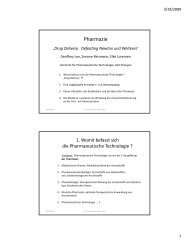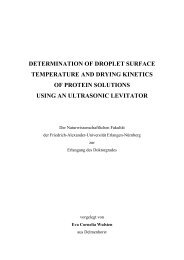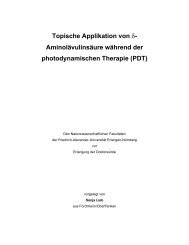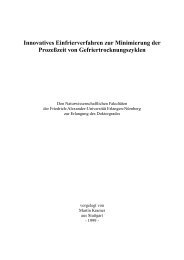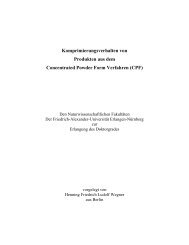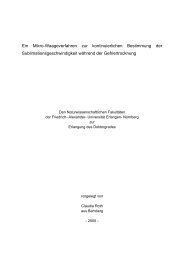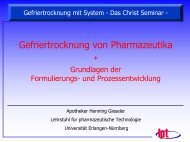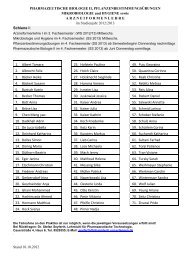Geoffrey Lee, Erlangen University Preparation & Formulation of ...
Geoffrey Lee, Erlangen University Preparation & Formulation of ...
Geoffrey Lee, Erlangen University Preparation & Formulation of ...
Create successful ePaper yourself
Turn your PDF publications into a flip-book with our unique Google optimized e-Paper software.
Vaccines under ConsiderationII: Malaria MVA & FP9Objective: To develop two strains <strong>of</strong> recombinant non-replicating pox virus constructs (MVA and FP9)and test the vaccines alone and in combination for safety and efficacy using the human challenge modelLead Partner: Oxford <strong>University</strong>, Oxford, United KingdomAdditional Partners: Oxxon Pharmaccines, Oxford, England; Impfst<strong>of</strong>fwerke Dessau-Tornan (IDT),Rosslau and Dessau, GermanyAgreement Duration: October 2001 – December 2003⎯⎯⎯⎯⎯⎯⎯⎯⎯⎯⎯⎯⎯⎯⎯⎯⎯⎯⎯⎯⎯⎯⎯⎯⎯⎯⎯⎯⎯⎯⎯<strong>Ge<strong>of</strong>frey</strong> <strong>Lee</strong>, <strong>Erlangen</strong>; MEU Oxford, Nov 2004Some Basic <strong>Formulation</strong> Guidelinesfor Stabilizing Biologicals in Solid State→ Problem: protein molecules in solid state aresufficiently mobile to show partial unfolding tonon-native forms= leads to aggregation & loss <strong>of</strong> activity→ Solution: protein dissolved in solid, amorphouscarrier, typically a disaccharide= stabilizes protein during drying process& on subsequent storage= Carpenter's 'water replacement' theory= Franks' 'glassy immobilization' theory⎯⎯⎯⎯⎯⎯⎯⎯⎯⎯⎯⎯⎯⎯⎯⎯⎯⎯⎯⎯⎯⎯⎯⎯⎯⎯⎯⎯⎯⎯⎯<strong>Ge<strong>of</strong>frey</strong> <strong>Lee</strong>, <strong>Erlangen</strong>; MEU Oxford, Nov 20043
Frequently Used Adjuvents in SolidProtein <strong>Formulation</strong>s1. Disaccharides- sucrose, T g = ca. 70 o C-trehalose, T g = ca. 115 o C2. Amino acids- basic amino acids form glasses on dryingfrom aqueous solution, eg arginine- most others crystallise on drying, eg glycine3. Sugar alcohols- crystalline mannitol = bulking agent- amorphous sorbitol (T g = 4 o C)4. Surfactants⎯⎯⎯⎯⎯⎯⎯⎯⎯⎯⎯⎯⎯⎯⎯⎯⎯⎯⎯⎯⎯⎯⎯⎯⎯⎯⎯⎯⎯⎯⎯<strong>Ge<strong>of</strong>frey</strong> <strong>Lee</strong>, <strong>Erlangen</strong>; MEU Oxford, Nov 2004Methods for Particle <strong>Preparation</strong>1. Freeze drying + milling- original PJ technique2. Spray drying (SD)- particle size specification necessitatespilot-scale maschine- patents ?3. Spray freeze drying (SFD)- simple laboratory-scale apparatus- use <strong>of</strong> LN24. Supercritical fluids- still considered a complicated technique⎯⎯⎯⎯⎯⎯⎯⎯⎯⎯⎯⎯⎯⎯⎯⎯⎯⎯⎯⎯⎯⎯⎯⎯⎯⎯⎯⎯⎯⎯⎯<strong>Ge<strong>of</strong>frey</strong> <strong>Lee</strong>, <strong>Erlangen</strong>; MEU Oxford, Nov 20044
I: SPRAY-FREEZE-DRYINGLab scale: ca 6 g powder pro batch⎯⎯⎯⎯⎯⎯⎯⎯⎯⎯⎯⎯⎯⎯⎯⎯⎯⎯⎯⎯⎯⎯⎯⎯⎯⎯⎯⎯⎯⎯⎯<strong>Ge<strong>of</strong>frey</strong> <strong>Lee</strong>, <strong>Erlangen</strong>; MEU Oxford, Nov 2004SFD: Process conditionsProcess variables: nozzle parameters (dropletsize distribution), FD cycle (1 o & 2 o drying conditions)Shelf temperature [ o C]3020100-10-20-30-40-5010008006004002000Chamber pressure [mbar]-2 0 2 4 6 8 10 12 14 16Time [h]⎯⎯⎯⎯⎯⎯⎯⎯⎯⎯⎯⎯⎯⎯⎯⎯⎯⎯⎯⎯⎯⎯⎯⎯⎯⎯⎯⎯⎯⎯⎯<strong>Ge<strong>of</strong>frey</strong> <strong>Lee</strong>, <strong>Erlangen</strong>; MEU Oxford, Nov 20045
SFD Lysozyme: Particle Morphology⎯⎯⎯⎯⎯⎯⎯⎯⎯⎯⎯⎯⎯⎯⎯⎯⎯⎯⎯⎯⎯⎯⎯⎯⎯⎯⎯⎯⎯⎯⎯<strong>Ge<strong>of</strong>frey</strong> <strong>Lee</strong>, <strong>Erlangen</strong>; MEU Oxford, Nov 2004SFD Lysozyme: Particle PropertiesLiquid feed solid's concentrationLiquid feed flow rateNozzle typeNozzle height from LN2 surfaceResidual moistureT gWAXSTap densityAngle <strong>of</strong> repose10 % w/w2 ml/min60 kHz5 cm3.16 % ± 0.25 % (n=4)none detectedfully amorphous0.012 g/ml ≅ 12 kg/m 358.0 o ± 3.7 o (n=4)⎯⎯⎯⎯⎯⎯⎯⎯⎯⎯⎯⎯⎯⎯⎯⎯⎯⎯⎯⎯⎯⎯⎯⎯⎯⎯⎯⎯⎯⎯⎯<strong>Ge<strong>of</strong>frey</strong> <strong>Lee</strong>, <strong>Erlangen</strong>; MEU Oxford, Nov 20046
SFD Trehalose: Particle MorphologySFD sampleWater contentT gTap densityTrehalose; 100kHz3.0 %70.1 o C0.14 g/ml ≅ 140 kg/m 3⎯⎯⎯⎯⎯⎯⎯⎯⎯⎯⎯⎯⎯⎯⎯⎯⎯⎯⎯⎯⎯⎯⎯⎯⎯⎯⎯⎯⎯⎯⎯<strong>Ge<strong>of</strong>frey</strong> <strong>Lee</strong>, <strong>Erlangen</strong>; MEU Oxford, Nov 2004SFD Mannitol: Particle MorphologySFD sampleWater contentT mTap densityMannitol; 100 kHz1.1 %165.7 o C0.31 g/ml ≅ 310 kg/m 3⎯⎯⎯⎯⎯⎯⎯⎯⎯⎯⎯⎯⎯⎯⎯⎯⎯⎯⎯⎯⎯⎯⎯⎯⎯⎯⎯⎯⎯⎯⎯<strong>Ge<strong>of</strong>frey</strong> <strong>Lee</strong>, <strong>Erlangen</strong>; MEU Oxford, Nov 20047
Hg Porosimetry <strong>of</strong> SFD Trehalose & MannitolSFD trehaloseSFD mannitol⎯⎯⎯⎯⎯⎯⎯⎯⎯⎯⎯⎯⎯⎯⎯⎯⎯⎯⎯⎯⎯⎯⎯⎯⎯⎯⎯⎯⎯⎯⎯<strong>Ge<strong>of</strong>frey</strong> <strong>Lee</strong>, <strong>Erlangen</strong>; MEU Oxford, Nov 2004SFD Trehalose/Mannitol: Crystallinity & Moisture⎯⎯⎯⎯⎯⎯⎯⎯⎯⎯⎯⎯⎯⎯⎯⎯⎯⎯⎯⎯⎯⎯⎯⎯⎯⎯⎯⎯⎯⎯⎯<strong>Ge<strong>of</strong>frey</strong> <strong>Lee</strong>, <strong>Erlangen</strong>; MEU Oxford, Nov 20048
SFD Trehalose/Mannitol/Dextran 37.5kDa (2:2:1)SFD sampleTMD (2:2:1); 100 kHzT g67.6 o CTap density0.31 g/ml≅ 310 kg/m 3⎯⎯⎯⎯⎯⎯⎯⎯⎯⎯⎯⎯⎯⎯⎯⎯⎯⎯⎯⎯⎯⎯⎯⎯⎯⎯⎯⎯⎯⎯⎯<strong>Ge<strong>of</strong>frey</strong> <strong>Lee</strong>, <strong>Erlangen</strong>; MEU Oxford, Nov 2004SFD TMD 10kDa (3:3:4)SFD sampleWater contentT gTap densityTMD (3:3:4); 100 kHz1.26% ± 0.02% (n=3)45 o C0.42 g/ml ≅ 420 kg/m 3⎯⎯⎯⎯⎯⎯⎯⎯⎯⎯⎯⎯⎯⎯⎯⎯⎯⎯⎯⎯⎯⎯⎯⎯⎯⎯⎯⎯⎯⎯⎯<strong>Ge<strong>of</strong>frey</strong> <strong>Lee</strong>, <strong>Erlangen</strong>; MEU Oxford, Nov 20049
SFD TMD 10kDa (3:3:4) + Lysozyme: Morphology0%5%10% 30%⎯⎯⎯⎯⎯⎯⎯⎯⎯⎯⎯⎯⎯⎯⎯⎯⎯⎯⎯⎯⎯⎯⎯⎯⎯⎯⎯⎯⎯⎯⎯<strong>Ge<strong>of</strong>frey</strong> <strong>Lee</strong>, <strong>Erlangen</strong>; MEU Oxford, Nov 2004SFD TMD 10kDa (3:3:4) + Lysozyme: Thermal BehaviourTMD (3:3:4)TMD (3:3:4) + 30% lysozyme⎯⎯⎯⎯⎯⎯⎯⎯⎯⎯⎯⎯⎯⎯⎯⎯⎯⎯⎯⎯⎯⎯⎯⎯⎯⎯⎯⎯⎯⎯⎯<strong>Ge<strong>of</strong>frey</strong> <strong>Lee</strong>, <strong>Erlangen</strong>; MEU Oxford, Nov 200410
SFD TMD 10kDa (3:3:4) + Lysozyme: PropertiesProperty0% protein5% protein10% protein30% proteinResidualmoisture [%]1.26% ±0.02% (n=3)1.27 ± 0.02(n=3 runs x 3)1.50 ± 0.06(n=3 runs x 3)1.02 ± 0.08(n=3 runs x 3)T g[ o C]455045120Tap density[g/ml]0.42 g/ml ≅420 kg/m 30.37 ± 0.006(n=3 runs x 1)0.38 ± 0.015(n=3 runs x 1)0.31 ± 0.012(n=3 runs x 1)-Angle <strong>of</strong>repose [ o ]51.2 ± 1.1(n=3 runs x 1)50.7 ± 4.5(n=3 runs x 1)45 ± 0 (n=3runs x 1)⎯⎯⎯⎯⎯⎯⎯⎯⎯⎯⎯⎯⎯⎯⎯⎯⎯⎯⎯⎯⎯⎯⎯⎯⎯⎯⎯⎯⎯⎯⎯<strong>Ge<strong>of</strong>frey</strong> <strong>Lee</strong>, <strong>Erlangen</strong>; MEU Oxford, Nov 2004SFD TMD 10kDa (10% Lysozyme) with ReducedMannitol Content: MorphologyTMD (3:1:4)TMD (3:3:4)TMD (3:0.5:4)⎯⎯⎯⎯⎯⎯⎯⎯⎯⎯⎯⎯⎯⎯⎯⎯⎯⎯⎯⎯⎯⎯⎯⎯⎯⎯⎯⎯⎯⎯⎯<strong>Ge<strong>of</strong>frey</strong> <strong>Lee</strong>, <strong>Erlangen</strong>; MEU Oxford, Nov 200411
SFD TMD 10kDa (10% Lysozyme) with ReducedMannitol Content: Thermal Behaviour⎯⎯⎯⎯⎯⎯⎯⎯⎯⎯⎯⎯⎯⎯⎯⎯⎯⎯⎯⎯⎯⎯⎯⎯⎯⎯⎯⎯⎯⎯⎯<strong>Ge<strong>of</strong>frey</strong> <strong>Lee</strong>, <strong>Erlangen</strong>; MEU Oxford, Nov 2004SFD Powders are Hygroscopic ! TM/D 10kDa ± 10% Lysozyme876Weight increase [%]543210(TM)(TM + 30% lyoszyme)(TMD)(TMD + 30 % lysozyme)-10 20 40 60 80 100Time in mins⎯⎯⎯⎯⎯⎯⎯⎯⎯⎯⎯⎯⎯⎯⎯⎯⎯⎯⎯⎯⎯⎯⎯⎯⎯⎯⎯⎯⎯⎯⎯<strong>Ge<strong>of</strong>frey</strong> <strong>Lee</strong>, <strong>Erlangen</strong>; MEU Oxford, Nov 200412
SFD Catalase: Enzyme Inactivation<strong>Formulation</strong>, SFDSolids'content<strong>of</strong> liquidfeed [%]Enzymaticactivity att=0 [%]TreatmentSFDResidual activity [%]68.2 ± 2.7 (n=3 x 3)Catalase1071Atomization into air98.6 ± 1.6 (n=3 x 3)catalase/trehalose(2:8)1099Atomisation into LN291.9 ± 1.6 (n=3 x 3)catalase/mannitol(2:8)1097FDnnnnnnncatalase/dextran 10kDa(2:8)1063⎯⎯⎯⎯⎯⎯⎯⎯⎯⎯⎯⎯⎯⎯⎯⎯⎯⎯⎯⎯⎯⎯⎯⎯⎯⎯⎯⎯⎯⎯⎯<strong>Ge<strong>of</strong>frey</strong> <strong>Lee</strong>, <strong>Erlangen</strong>; MEU Oxford, Nov 2004SFD TMH 200Da (3:3:4)Hydroxy ethyl starch (200kDa) in place <strong>of</strong> dextran (10kDa)60 kHz, 35% total solids 60 kHz, 5% total solids⎯⎯⎯⎯⎯⎯⎯⎯⎯⎯⎯⎯⎯⎯⎯⎯⎯⎯⎯⎯⎯⎯⎯⎯⎯⎯⎯⎯⎯⎯⎯<strong>Ge<strong>of</strong>frey</strong> <strong>Lee</strong>, <strong>Erlangen</strong>; MEU Oxford, Nov 2004SFD End13
II: SPRAY-DRYING1. Laboratory-scale micro spray dryer has low drying capacity- 1 kg water/h at T inlet= 220 o Calso: droplet/particle residence time is < 1s→ limits dry particle size to ≤ 20 µm (irrespective <strong>of</strong> nozzle)2. Pilot-scale spray dryer can produce particles <strong>of</strong> around 50µm- requires liquid feed volumes > 500 ml3. Consequences:i) formulation work with biologicals can only be performedwith micro spray dryer→ particles too small for testing with device !ii) evaluation <strong>of</strong> device suitability requires pilot-scale spraydryer⎯⎯⎯⎯⎯⎯⎯⎯⎯⎯⎯⎯⎯⎯⎯⎯⎯⎯⎯⎯⎯⎯⎯⎯⎯⎯⎯⎯⎯⎯⎯<strong>Ge<strong>of</strong>frey</strong> <strong>Lee</strong>, <strong>Erlangen</strong>; MEU Oxford, Nov 2004Büchi B-290 Micro-Scale LaboratorySpray DryerMax. temp. <strong>of</strong> drying air 220°CMax. drying capacity 1.5 kg H 2 O/hMax. throughput <strong>of</strong> drying air ca. ca. 45 m 3 /hCompressed air flow 5 - 8 barCompressed air consumption max. 1000 l/hDimensions 500 x 600 x 1000 mmSD TMD (3:3:4):T inlet/T outlet= 130 o C/85 o Cv da= 35 m 3 /hv lf= 3 ml/min; v aa= 0.7 m 3 /hlf solids' content = 35% w/w→ powder yield < 7%⎯⎯⎯⎯⎯⎯⎯⎯⎯⎯⎯⎯⎯⎯⎯⎯⎯⎯⎯⎯⎯⎯⎯⎯⎯⎯⎯⎯⎯⎯⎯<strong>Ge<strong>of</strong>frey</strong> <strong>Lee</strong>, <strong>Erlangen</strong>; MEU Oxford, Nov 200414
SD Trehalose/Dextran 10kDaMixtures: Yield353025Product Yield [%]201510500 20 40 60 80 100Weight Fraction <strong>of</strong> Dextran 10kDa [%]⎯⎯⎯⎯⎯⎯⎯⎯⎯⎯⎯⎯⎯⎯⎯⎯⎯⎯⎯⎯⎯⎯⎯⎯⎯⎯⎯⎯⎯⎯⎯<strong>Ge<strong>of</strong>frey</strong> <strong>Lee</strong>, <strong>Erlangen</strong>; MEU Oxford, Nov 2004SD TD 10kDaMixtures: Moisture & T g6.0140Residual water [%]5.55.04.54.03.53.0= TMD (3:3:4)13012011010090T g[ o C]2.5800 20 40 60 80 100Weight fraction <strong>of</strong> dextran 10kDa [%]⎯⎯⎯⎯⎯⎯⎯⎯⎯⎯⎯⎯⎯⎯⎯⎯⎯⎯⎯⎯⎯⎯⎯⎯⎯⎯⎯⎯⎯⎯⎯<strong>Ge<strong>of</strong>frey</strong> <strong>Lee</strong>, <strong>Erlangen</strong>; MEU Oxford, Nov 200415
SD TD 10kDa (3:4) + Mannitol: Yield353025average yield for all T/D binary mixturesProduct Yield [%]201510500 20Weight Fraction <strong>of</strong> Mannitol [%]⎯⎯⎯⎯⎯⎯⎯⎯⎯⎯⎯⎯⎯⎯⎯⎯⎯⎯⎯⎯⎯⎯⎯⎯⎯⎯⎯⎯⎯⎯⎯<strong>Ge<strong>of</strong>frey</strong> <strong>Lee</strong>, <strong>Erlangen</strong>; MEU Oxford, Nov 2004SD TD 10kDa (3:4) + Mannitol: Moisture & T g90T g[ o C]80706042Residual water [%]50400 5 10 15 20 25 30Weight fraction <strong>of</strong> mannitol [%]0⎯⎯⎯⎯⎯⎯⎯⎯⎯⎯⎯⎯⎯⎯⎯⎯⎯⎯⎯⎯⎯⎯⎯⎯⎯⎯⎯⎯⎯⎯⎯<strong>Ge<strong>of</strong>frey</strong> <strong>Lee</strong>, <strong>Erlangen</strong>; MEU Oxford, Nov 200416
Various SD TD 10kDa + M Mixtures: MorphologyTD (1:0)TD (3:4)TD (0:1) TMD (3:3:4)⎯⎯⎯⎯⎯⎯⎯⎯⎯⎯⎯⎯⎯⎯⎯⎯⎯⎯⎯⎯⎯⎯⎯⎯⎯⎯⎯⎯⎯⎯⎯<strong>Ge<strong>of</strong>frey</strong> <strong>Lee</strong>, <strong>Erlangen</strong>; MEU Oxford, Nov 2004SD TD 10kDa (3:4) + Lysozyme: Morphology0% protein 10% protein30% protein⎯⎯⎯⎯⎯⎯⎯⎯⎯⎯⎯⎯⎯⎯⎯⎯⎯⎯⎯⎯⎯⎯⎯⎯⎯⎯⎯⎯⎯⎯⎯<strong>Ge<strong>of</strong>frey</strong> <strong>Lee</strong>, <strong>Erlangen</strong>; MEU Oxford, Nov 200417
SD TD 10kDa (3:4) + Lysozyme: PropertiesProperty0% protein5% protein10% protein30% proteinResidual moisture[%]4.61% ± 0.08%(n=3 runs x 3)1.30 % ± 0.1 %(n=3 runs x 3)1.86 % ± 0.1 %(n=3 runs x 3)1.85 % ± 0.14 %(n=3 runs x 3)T g[ o C]9110598107Yield [%]34±5 (n=3)42±7 (n=3)47.5±2 (n=3)40.9±2 (n=3)⎯⎯⎯⎯⎯⎯⎯⎯⎯⎯⎯⎯⎯⎯⎯⎯⎯⎯⎯⎯⎯⎯⎯⎯⎯⎯⎯⎯⎯⎯⎯<strong>Ge<strong>of</strong>frey</strong> <strong>Lee</strong>, <strong>Erlangen</strong>; MEU Oxford, Nov 2004SD TD 10kDa (3:4) + 30% Lysozyme:Thermal Behaviour^exo Charge 035-2003 (0-160°C) 28.08.2003 15:59:32]6[&!Charge 035-2003 (0-160°C)Charge 035-2003 (0-160°C), 15,0000 mgGlasumwandlungOnset 121,67 °CMittel. 129,57 °CWendept. 130,91 °CWendesteigung -6,15e-03 Wg^-1°C^-1Linke Grenze 101,54 °CRechte Grenze 157,32 °C1Wg^-1]4[&!Charge 035-2003 (0-160°C)Charge 035-2003 (0-160°C), 15,0000 mg]2[&!Charge 035-2003 (0-160°C)Charge 035-2003 (0-160°C), 15,0000 mgGlasumwandlungOnset 116,51 °CMittel. 123,37 °CWendept. 124,41 °CWendesteigung -6,34e-03 Wg^-1°C^-1Linke Grenze 107,27 °CRechte Grenze 151,57 °C-20 0 20 40 60 80 100 120 140 °CDEMO Version METTLER TOLEDO S TA R e System⎯⎯⎯⎯⎯⎯⎯⎯⎯⎯⎯⎯⎯⎯⎯⎯⎯⎯⎯⎯⎯⎯⎯⎯⎯⎯⎯⎯⎯⎯⎯<strong>Ge<strong>of</strong>frey</strong> <strong>Lee</strong>, <strong>Erlangen</strong>; MEU Oxford, Nov 200418
SD TD 10kDa (3:4) + Lysozyme: Stability at 25 o C110Residual activity [%]105100959085lysolyso05lyso10lyso3080750 1 2 3 4 5 6 7 8 9 10 11 12Storage time [months]⎯⎯⎯⎯⎯⎯⎯⎯⎯⎯⎯⎯⎯⎯⎯⎯⎯⎯⎯⎯⎯⎯⎯⎯⎯⎯⎯⎯⎯⎯⎯<strong>Ge<strong>of</strong>frey</strong> <strong>Lee</strong>, <strong>Erlangen</strong>; MEU Oxford, Nov 2004SD TD 10kDa (3:4) + Lysozyme: Stability at 4 o C110Residual activity [%]105100959085lysolyso5lyso10lyso3080750 1 2 3 4 5 6 7 8 9 10 11 12Storage time [months]⎯⎯⎯⎯⎯⎯⎯⎯⎯⎯⎯⎯⎯⎯⎯⎯⎯⎯⎯⎯⎯⎯⎯⎯⎯⎯⎯⎯⎯⎯⎯<strong>Ge<strong>of</strong>frey</strong> <strong>Lee</strong>, <strong>Erlangen</strong>; MEU Oxford, Nov 200419
Attrition <strong>of</strong> SFD & SD ParticlesSFD: standard procedureSD: pilot-scale spray dryerSimple attrition test at 40, 60 & 80 bar:Particle size distribution measured via microscopySystems: mannitol, lactose, TMD, TMH⎯⎯⎯⎯⎯⎯⎯⎯⎯⎯⎯⎯⎯⎯⎯⎯⎯⎯⎯⎯⎯⎯⎯⎯⎯⎯⎯⎯⎯⎯⎯<strong>Ge<strong>of</strong>frey</strong> <strong>Lee</strong>, <strong>Erlangen</strong>; MEU Oxford, Nov 2004Attrition <strong>of</strong> SD Lactose (40 bar)before actuation!after actuation⎯⎯⎯⎯⎯⎯⎯⎯⎯⎯⎯⎯⎯⎯⎯⎯⎯⎯⎯⎯⎯⎯⎯⎯⎯⎯⎯⎯⎯⎯⎯<strong>Ge<strong>of</strong>frey</strong> <strong>Lee</strong>, <strong>Erlangen</strong>; MEU Oxford, Nov 200420
Attrition <strong>of</strong> SFD Lactose (40 bar)before actuation!after actuation⎯⎯⎯⎯⎯⎯⎯⎯⎯⎯⎯⎯⎯⎯⎯⎯⎯⎯⎯⎯⎯⎯⎯⎯⎯⎯⎯⎯⎯⎯⎯<strong>Ge<strong>of</strong>frey</strong> <strong>Lee</strong>, <strong>Erlangen</strong>; MEU Oxford, Nov 2004Attrition <strong>of</strong> SD Mannitol (40 bar)before actuationafter actuation⎯⎯⎯⎯⎯⎯⎯⎯⎯⎯⎯⎯⎯⎯⎯⎯⎯⎯⎯⎯⎯⎯⎯⎯⎯⎯⎯⎯⎯⎯⎯<strong>Ge<strong>of</strong>frey</strong> <strong>Lee</strong>, <strong>Erlangen</strong>; MEU Oxford, Nov 200421
Attrition <strong>of</strong> SFD Mannitol (40 bar)before actuationafter actuation⎯⎯⎯⎯⎯⎯⎯⎯⎯⎯⎯⎯⎯⎯⎯⎯⎯⎯⎯⎯⎯⎯⎯⎯⎯⎯⎯⎯⎯⎯⎯<strong>Ge<strong>of</strong>frey</strong> <strong>Lee</strong>, <strong>Erlangen</strong>; MEU Oxford, Nov 2004Mean particle diameter after actuation in % <strong>of</strong> the initial meanSummary <strong>of</strong> diameter Attrition Results100.00%Mean particle diameter after actuation in % <strong>of</strong>the initial mean diameter90.00%80.00%70.00%60.00%50.00%40.00%30.00%20.00%10.00%0.00%40 bar 60 bar 80 barLactose SD 10%Mannitol SD 10%Lactose SFD 10%Trehalose SFD 10%Mannitol SFD 10%SFD: ≤ 10%Actuation Pressure⎯⎯⎯⎯⎯⎯⎯⎯⎯⎯⎯⎯⎯⎯⎯⎯⎯⎯⎯⎯⎯⎯⎯⎯⎯⎯⎯⎯⎯⎯⎯<strong>Ge<strong>of</strong>frey</strong> <strong>Lee</strong>, <strong>Erlangen</strong>; MEU Oxford, Nov 200422
Attrition <strong>of</strong> SFD TMD (3:3:4)40 bar60 bar 80 bar⎯⎯⎯⎯⎯⎯⎯⎯⎯⎯⎯⎯⎯⎯⎯⎯⎯⎯⎯⎯⎯⎯⎯⎯⎯⎯⎯⎯⎯⎯⎯<strong>Ge<strong>of</strong>frey</strong> <strong>Lee</strong>, <strong>Erlangen</strong>; MEU Oxford, Nov 2004Summary <strong>of</strong> SFD TMD/LMD Attrition Results85.00%Mean particle diameter after actuation in % <strong>of</strong>the initial mean diameter80.00%75.00%70.00%65.00%60.00%55.00%50.00%45.00%LMD (3+3+4) SFD 10%TMD (3+3+4) SFD 10%LMD (3+3+3) SFD 10%TMD (3+3+3) SFD 10%LMD (3+3+2) SFD 10%TMD (3+3+2) SFD 10%40.00%40 bar 60 bar 80 barActuation Pressure⎯⎯⎯⎯⎯⎯⎯⎯⎯⎯⎯⎯⎯⎯⎯⎯⎯⎯⎯⎯⎯⎯⎯⎯⎯⎯⎯⎯⎯⎯⎯<strong>Ge<strong>of</strong>frey</strong> <strong>Lee</strong>, <strong>Erlangen</strong>; MEU Oxford, Nov 200423
<strong>Preparation</strong> <strong>of</strong> Vaccine Powders ?1. Establish stability <strong>of</strong> vaccines in current liquid& freeze-dried formulations;2. Decision: SFD versus SD, or both ?3. <strong>Formulation</strong> tactic to achieve satisfactory particleproperties and process/storage stability (25 o C, 4 o C ?);4. Assessent <strong>of</strong> long-term storage stability.Which work under cgmp conditions ?Need for powder sterility ?Conditioned-air requirement, powder hygroscopicity ?www.pharmtech.uni-erlangen.de⎯⎯⎯⎯⎯⎯⎯⎯⎯⎯⎯⎯⎯⎯⎯⎯⎯⎯⎯⎯⎯⎯⎯⎯⎯⎯⎯⎯⎯⎯⎯<strong>Ge<strong>of</strong>frey</strong> <strong>Lee</strong>, <strong>Erlangen</strong>; MEU Oxford, Nov 200424




